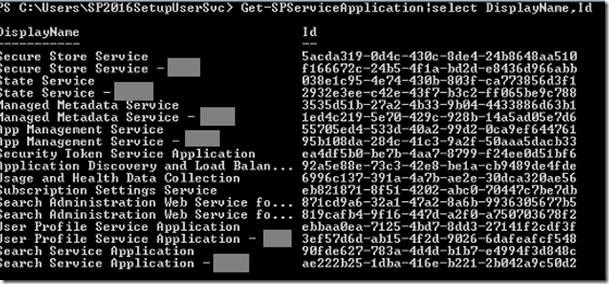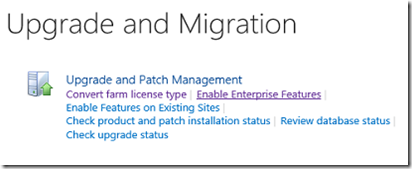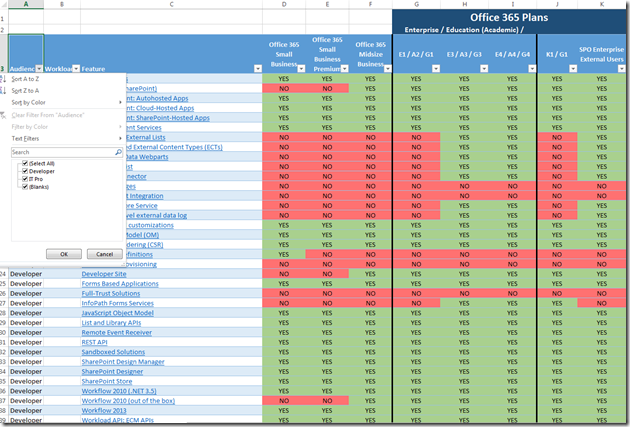
Microsoft has a service in preview, called QnA Maker. It is a free (presently) service, which provides a REST and web-based service that trains AI to respond to questions asked of it. You’ve seen these on other sites, as these have become quite common, and ease the burden on support for SharePoint, or any other service out there. Chat bots can field common questions, freeing up time and energy spent on answering common asks.
They make it very easy to use – you can point it to a URL, type in your questions and answers, or upload a document (.docx, .doc, .pdf, .xlsx, and .tsv). The tricky part, is getting this from loading your knowledge base, to actually having a chat bot on your site. This is what this blog post is for, is to show you how to do it. They do have directions, but not a full walk-through on what to do.
This post assumes that you have at the very least, an Azure Account. If not, you can start one for free.
QnA Maker Setup
First, go to http://qnamaker.ai, this is where you will get started. Click on Create New Service

Then sign in with a Microsoft ID, or organizational account like you would into Azure, Office365, Outlook.com, etc.

It will then ask you to provide permissions to QnAMaker, click Accept
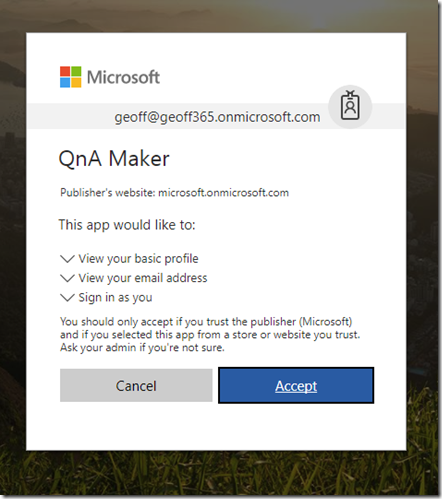
Then you must agree to the terms and privacy statement, check the box and hit Continue

Enter in a name for your bot. I am choosing Testbot 9001

You now have 3 options for loading data into your Chat Bot…
- From a URL that links to a resource which has a clear Q&A format, like a FAQ
- From a file, in Question/Answer format (supported file types are .TSV*, .PDF, .DOC, .DOCX, and .XLSX format)
*TSV stands for Tab Separated Values. Like a CSV, but, you know, with Tabs. You can do this in Excel.
- Enter them in manually
For our Testbot 9001, we will be uploading from Excel. So, let’s create a new Excel file. In the first column, type in the question, or phrase, which the chatbot AI will hit on and use to provide the answer. Use the second column to provide that answer. Here is my example file:

Now, save the file. And go back to the QnA Maker setup, and choose Select file… next to the FILES section

and select the XLSX file from your local computer you just saved

Then scroll to the bottom and select Create

You will then see a dialog window appear while the service scans your file, and imports your Questions and Answers
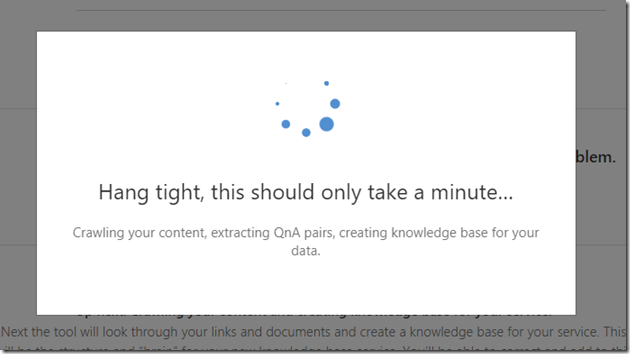
Once complete, it will take you to the Testbot 9001 Knowledgebase.

Select Test from the side bar, and you can test the functionality with your questions
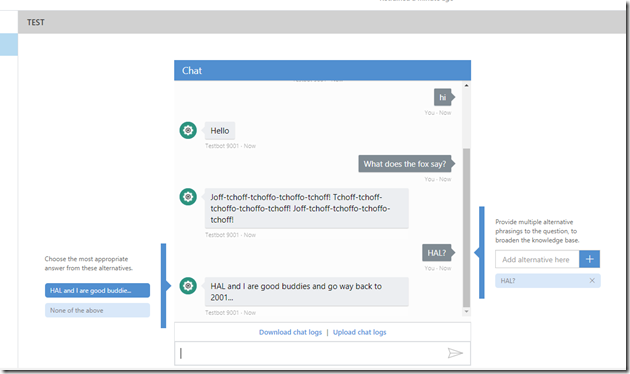
Cool, huh? The testing also allows you to train the bot as well. Such as choosing the best answer based upon what you had typed
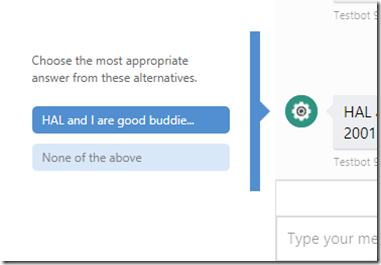
Or providing multiple alternative phrasings, or synonyms

When done, click Save and Retrain to save your changes

You can see back in the main Knowledgebase, that it has been updated by what we asked and what we updated the suggestions and phrasings with

You can also add new Q & A pairs by clicking on Add new QnA pair


When done, Save & Retrain again to save your settings.
Once you are ready… click Publish

It will then show you what will be published… and then when ready, click Publish
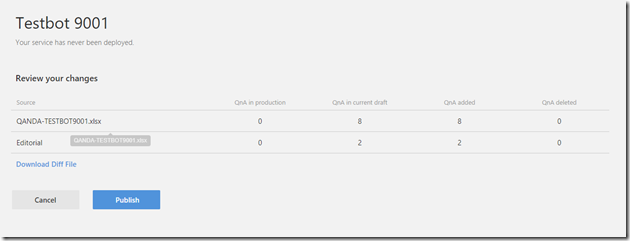
The deployment confirmation screen will show you the example HTTP request for using your bot through the REST API. These are also available in the Settings link on the sidebar of the Knowledgebase.
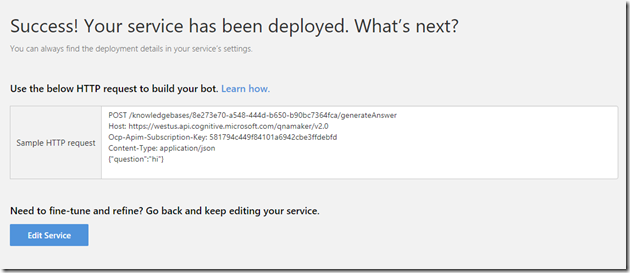
We will need some f this information in a few minutes, so take down the Knowledgebase ID

And the Subscription Key

and put those aside for a few minutes…
Azure Bot Service Setup
Next we’re going to use the Azure Bot Service to setup our bot. To do so, we’ll be following these instructions: https://docs.microsoft.com/en-us/bot-framework/bot-service-quickstart
Log into the Azure Portal
Click on New > AI + Cognitive Services > Web App Bot

Now, let’s configure the bot
- Name: Testbot9001
So you can identify the soldiers in your bot army!
- Subscription: GeoffOps
Choose your own subscription. This one is mine. You can’t have it.
- Resource Group: Testbot9001
Use an existing or create a new one
- Location: East US
Select the data center region you would like to use
- Pricing Tier: FO (10K Premium Messages)
This defaults to S1 Standard, change this to F0 Free. Or else you will pay for the service
- App Name: Testbot9001
- Bot template: Question and Answer
- App service plan/Location: Testbot9001
You will need to create a new one, or use an existing. For this example, I created a new one also in East US
- Azure Storage: testbot9001a325
I am letting Azure create a new one for me. This is a data storage account, like a fileshare. You can use an existing one if you have one as well.
- Application Insights: Off
This is not free. So I turned it off.
Then click Create to bring life to your Azure Bot. I twill validate your choices, and then when complete, will begin deployment.

When deployment has completed, you can find the bot and associates Azure resources under the All Resources blade of the left, or, if you have other stuff in Azure, go to the Resource Groups blade, and click on your Resource Group we created in the Bot setup above. In my case, the Resource Group is Testbot9001

Ok. So, we’ve created our bot with QnA Maker, and created a Bot Service in Azure… now what? We need to connect the two.
Select your bot, it’ll be the one which has a TYPE of Web App Bot

On the left hand side, click on APP SERVICE SETTINGS > Application Settings

And then scroll down to App settings. You will see two blank settings called QnAKnowledgebaseId and QnASubscriptionKey
Now, remember those things we copied off earlier? Pate these in there.

And then click Save up top

Now, click on Test in Web Chat on the left side, and test out your new bot!

Pretty neat! But… now what?
Click on Channels on the left side. You will see Web Chat setup and running by default. You can also see, you can extend this out to Teams, Skype, and more pretty easily.
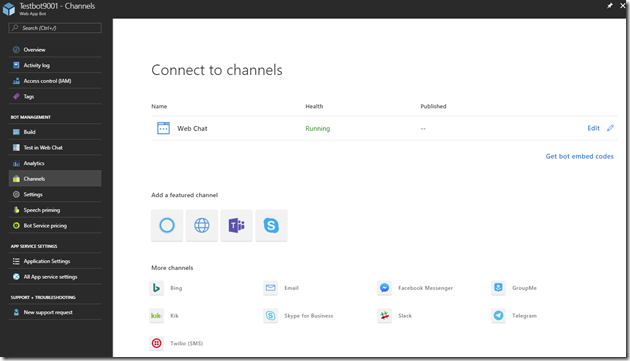
Click on Edit, and copy the Embed Code

And show one of the keys at the top

and replace the YOUR_SECRET_HERE in the embed code

And you can now drop that into a site, web part, whatever you’d like. It’s just an iFrame, so the possibilities are endless.
A simple example – using Embed Code on a SharePoint page:



Would I implement it like this for a client? Likely not… I’d be more apt to have a sliding pop-up window, similar to Facebook chats that can be minimized and maximized as needed. This was just an example to show how to build one of these.
References












































